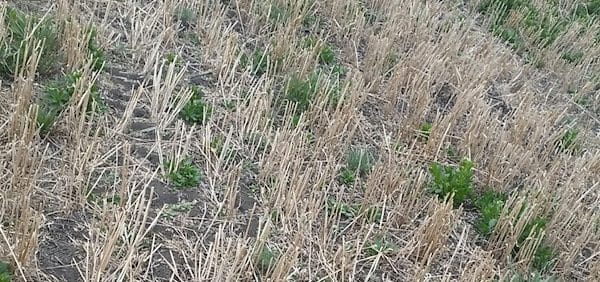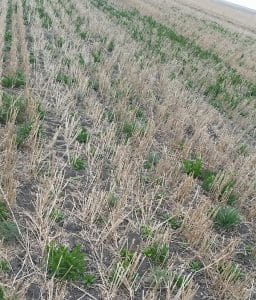Early weed control with lower efficacy is generally preferable to no control at all or late control with higher efficacy — as long as weeds are present and not frost damaged.
Spraying in cool, cloudy conditions
After a nighttime frost or near-frost event, the herbicide activity on a cloudy cool day would be next to zero. Biological activity would have stopped during the night, and would not start up again until the plant warmed to at least 5°C — and even then it would be very slow. A few hours between 5°C and a daytime peak of 10°C would not be enough warmth to get plant metabolism going to a point where herbicide was all that effective, especially with the cloud cover. No biological activity = no herbicide activity.
Ideally, you want a day or two of warm and sun with nighttime lows of 5°C or higher before spraying. If applied more than 48 hours before the frost event, efficacy on living plants will be retained and the plant will continue to decline when it warms up again.
Spraying weeds after a frost
Light frost. After a light frost, spraying could resume when the following conditions are met:
—A minimum of one night, preferably two, with minimum temperatures of 5°C — the minimum for biological activity to occur, and…
—A minimum of one day, preferably two, of good growing conditions (warm and sunny) have passed, and…
—Good growing conditions (warm, not hot, and sunny) are present at the time of spraying, and…
—You see no evidence of frost damage (blackening and water soaked appearance) on the crop or the weeds. “Crop” is included here because even a herbicide tolerant canola crop requires that the metabolism of the plant be working at full capacity to enable it to effectively process the herbicide and prevent injury.
Heavy frost. After a heavy frost, check for damaged tissues such as water soaked and darkened leaves that eventually lead to necrosis (dead, dry tissue). If tissue damage is greater than 40% of total leaf area, allow new leaves to grow before making herbicide applications.
Weeds stressed and weakened by frost are not more susceptible to herbicide. In fact, herbicide will likely have lower efficacy on weakened weeds.
Because of the above concerns, chemical companies may not be able to guarantee their products’ performance if applied too soon after a frost. And for some products, performance may be reduced if applied at temperatures below (or above) a certain temperature. Always talk to your local product rep to see how they will support the use of their product following a frost or cool temperatures. Performance restrictions can also be found in the provincial guides to crop production. Alberta Saskatchewan Manitoba
No time to wait? Growers who want to do a preseed burnoff and then get seeding may not want to wait 3-4 days for the weeds to recover from a frost. In this situation, growers should recognize that if they go ahead and spray right away, efficacy may be reduced.
However, even with the lower efficacy, doing the burnoff and then seeding may provide a higher return than seeding without the preseed burn and letting all the weeds compete until an early in-crop application. Consult with your supplier for information on product performance in these conditions to determine the best approach.
In all cases, it helps to know the weed spectrum and weed sizes before deciding the best course of action. Weigh the pros and cons of each option, and set expectations accordingly.

